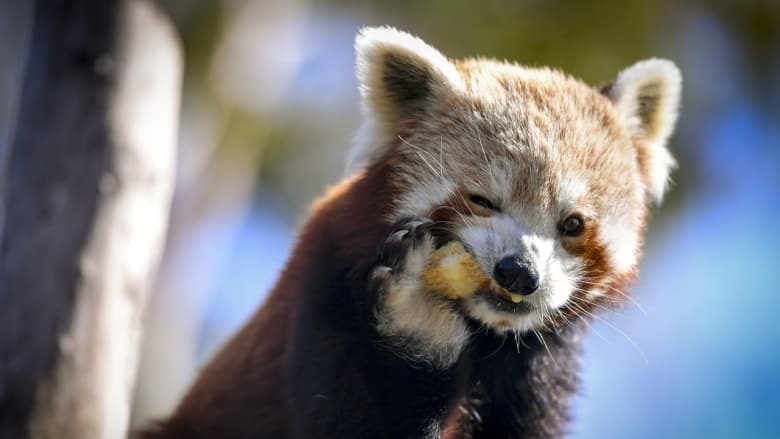Fruit is vital in human diets, and we all need to eat more. But at the zoo, keepers found fruit-heavy diets were making some animals obese - and rotting their teeth.
Comment: It's also possible that part of the problem is that, in the wild, these animals would have a greater access to a variety of foods, other than fruit, such as insects and meat.
"The issue is the cultivated fruits have been genetically modified to be much higher in sugar content than their natural, ancestral fruits," says Dr Michael Lynch, the zoo's head vet.
"It's interesting. After doing a lot with nutrition here, I tend to eat less fruit."
Monkeys love bananas. But now, says Dr Lynch, the zoo's primates don't get any fruit at all.
For humans, eating fruit is associated with a reduced risk of coronary heart disease, stroke, obesity, gastric cancer and lung cancer, an evidence review commissioned by the federal government found.
Comment: There is some deadly cognitive dissonance occurring here: Why would modern fruits be detrimental to the health of animals, who are precisely adapted to eat them, and yet still be considered healthy for humans, who are adapted to a predominantly meat and fat (hunter-gatherer) diet? Obesity and other diet related health issues are reaching epidemic proportions and the beginnings of these problems correlate closely with the implementation of current government dietary guidelines.
Despite fruit's sugar content, increasing your fruit intake does not increase your risk of type 2 diabetes. Fruits contain important nutrients, and fruit's natural sugars are very different from the harmful '"free sugars" in soft drinks.
Comment: For the most part, there is no nutrient that can be found in fruit that cannot be found elsewhere, in a safer form, i.e. without the harms associated with fructose.
But the zoo's experience is interesting for what it tells us about how agriculture has changed the fruits we eat.
"Pretty much all cultivated varieties at present are sweeter than their wild counterparts," says Dr Senaka Ranadheera, a food scientist at the University of Melbourne.
"For example, wild apples are smaller and more bitter than modern cultivated varieties."
Dr Ranadheera said there were reports of some fruits, such as plums, almost doubling in soluble sugar content in the past 20 years (fruit sugar levels are still nowhere near those in soft drinks or fruit juice).
And farmers have bred watermelons to have bright red fleshy interiors when ripe. Wild watermelons have a much smaller edible interior.
Wild bananas are filled with seeds; in the varieties we pick up from Coles or Woolies, the seeds have been shrunk so small they are almost invisible.
This has come about through decades - centuries, in some cases - of selective breeding.
"Throughout the ages, farming has favoured the plants that are pleasurable to eat such as the ones that have less of the bitterness and more of the sweetness," says Dr Nenad Naumovski, who lectures in food science at the University of Canberra.
"This also masks the bitterness of the phytochemicals that the particular fruit has."
Melbourne Zoo had traditionally fed its animals a fruit-heavy diet, says Dr Lynch.
That caused a range of health problems, but also made it hard for keepers to ensure everyone was getting a balanced diet.
"Fruit is a highly desired item because of its sugar content. So many animals, especially primates and red pandas, they will selectively eat the fruit but not other elements."
Like children, red pandas would quite happily eat nothing but bamboo and fruit, Dr Lynch says, missing out on a range of important nutrients.
So the zoo now makes "panda pellets": all the vitamins and minerals a red panda needs, mixed in with a little bit of pear. The pandas find them delicious.
Since Dr Lynch started at the zoo, they've been systematically replacing most of the fruit with green leafy vegetables. Dr Lynch has done the same for his diet, and now tries to get as many leafy greens as possible.
The zoo's seals have a different problem. If you freeze and then thaw a piece of fish, you can lose some of the fish's vitamins. So keepers have to make sure plenty of fresh fish is available too.
"A seal in the wild is eating fresh fish. We're feeding them something that's been caught, frozen, thawed. Fresh is best for most things," says Dr Lynch.




More bitter? They are so acidic they could beat coca-cola, heh. But the flavour is great.
I was always sceptic of the "vegetable and fruit is good for you" mantra. Fruits, because of their sugar content, are very different to vegetables, and it was strange to me they are almost always put together, as if they were the same. There is a reason they have different labels, even if sometimes it's hard to qualify some plant either as a vegetable or a fruit (like in legumes, where edible parts are botanically fruits or even seeds inside fruits, but they are usually treated as vegetables by dieticians).